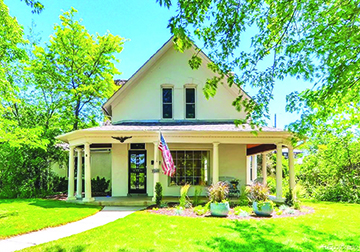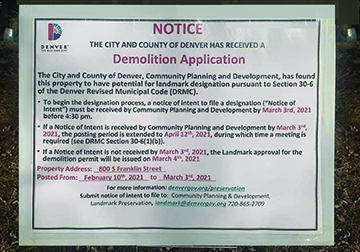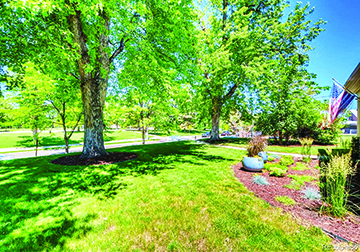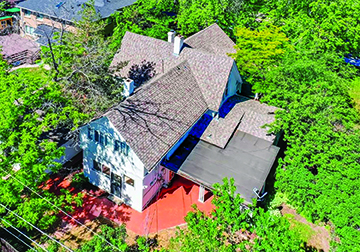Wash Park Home Built In The 1890s Faces Wrecking Ball; ‘Park Won’t Be The Same If Home Is Razed,’ Residents Stress
by Glen Richardson

Stunning Site: Home, sweet historic home’s prominent location creates an established and familiar feature for both Wash Park and the Mile High City.
In a neighborhood where real estate is in high demand, demolition threatens a rare Wash Park Queen Anne home built no later than 1890. Neighbors were surprised and shocked when a demolition notice was posted at the 800 S. Franklin St. home by the City & County of Denver.
The oldest occupiable property from the 19th Century remaining in the neighborhood, it is located on a large corner lot across Franklin St. from Wash Park and across E. Ohio Ave. from St. John’s Church. The home is a rare remaining example of the Queen Anne Style in West Washington Park.
Representing the distinctive visible characteristics of a Queen Anne, it has the asymmetrical massing including projecting octagonal bays, steep gabled roofs, deep classical eaves and hooded windows. The porch features Tuscan order columns and classical entablature — an architectural section located above the columns on the building’s exterior. Largely developed  in the period between the world wars, many of the houses in the neighborhood were constructed in more revivalist or eclectic styles such as Tudor revival or Craftsman.
in the period between the world wars, many of the houses in the neighborhood were constructed in more revivalist or eclectic styles such as Tudor revival or Craftsman.
Saving Historic Site
Ironically the bid to bulldoze the $2,300,000 home was posted in March as Historic Denver began celebrating five-decades of saving and highlighting historic treasures under threat of annihilation. The non-profit got started by saving the Molly Brown House from demolition in 1970. The organization is hosting a 50th bash at the Molly Brown House Museum now through Sept. 19. The celebration includes a “50 Actions for 50 Places” campaign for sites worthy of preservation action.
Sixth generation Coloradan Drew Carder — who has spent nearly his entire life in Wash Park — is among the neighborhood admirers and supports nominating the Franklin St. home as a community mecca worthy of preservation protection. He says he doesn’t know much about the home other than it is one of the last remaining pieces of the neighborhood’s history. “I feel like this community should be given more of a chance to respond.”
Like Carder, Justin Moorland has spent most of his life in or around Wash Park. Today he lives on the 600 block of S. Gilpin, one block away from the Franklin St. house. “It has always been my favorite home at the park. I find it unique because of its obvious age, modesty and setting. It is truly from another era.” Admits Liz Schanker, “I guess that proximity gives me extra incentive to save the home.” She lives right next door to 800 S. Franklin and says she has lived in Wash Park long enough to be able to imagine the structure that would go up on the site and doesn’t want that to happen. “There is a plethora of new, urban mansions in the neighborhood but only one white farmhouse that predates the park.”
Stunning Setting

Stunning Site: Home, sweet historic home’s prominent location creates an established and familiar feature for both Wash Park and the Mile High City.
Set far back from Franklin St., the home has an unusually large front yard at the corner of E. Ohio. Because of the house’s large, open lot and prominent location, it creates an established and familiar feature for both Wash Park and the Mile High City. One of the neighborhood’s first buildings, it was constructed before the City of Denver became the City and County of Denver. Moreover, despite its age the house retains a high degree of integrity.
The original Queen Anne structure has experienced some alterations including the stuccoing of the masonry, the northern addition plus alterations to some window openings. Nonetheless, it still retains integrity of design, materials and workmanship to communicate its Queen Anne style. The home is in its original locations, and while the area around the house has been altered over time, the house retains its setting through its relationship to Washington Park and Smith Lake. The interior includes a breakfast nook, vaulted ceilings, walk-in closets and fireplace. The structure is encircled by a wrap-around front porch.
Bid To Bulldoze
Wash Park developer-builder Aaron Grant is the person seeking demolition of the historic home. He is owner-managing-broker of South Gaylord St.-based Grant Real Estate Co. Retailers and residents will recall it was his firm that bulldozed long-standing stores along Denver’s second oldest commercial block to build Park Coworking. The company website claims, “We maintain history and character in the Wash Park neighborhood through real estate design and development.”
In conversations with relatives of the owner who sold the house to Grant Real Estate, neighbors were purportedly told that Grant articulated to them “what they wanted to hear as a seller.”

Treasure Threatened: Demolition threatens this rare Queen Ann home located across Franklin St. from Wash Park. The oldest occupiable property from the 19th Century remaining in the neighborhood, the house has retained a high degree of integrity despite its age.
At the time he was purchasing the property, Grant also allegedly indicated that he wanted to keep the shell of the home and remodel the interior. “We know now this was probably never his intent,” they say.
Noteworthy Owners
According to the Denver Assessor’s records, 800 S. Franklin St. was constructed in 1890. If the date is accurate, it would make the house one of the earliest remaining buildings in the West Wash Park neighborhood. Additionally, it confirms the house was built prior to the City of Denver becoming the City and County of Denver, which was not until 1902.
The earliest record of home ownership was by lumber tycoon Joseph Sterling who started Sterling Lumber & Investment Co. Records suggest, however, the house may be older that 1890 as a 1900 fire destroyed building records prior to 1890. The last prominent person to live in the Franklin home was William H. Burnett, a distinguished jurist who served on the Denver County Court for 17 years.
In 1964 Burnett served as President of the Judicial Research Foundation and became head of the American Bar Association’s Section of Judicial Administration. The judge lived at the Franklin St. address with his wife Margaret from 1963 until his death in 1973. He was at the height of his career when he lived at the address, therefore the property bears a strong association with him and his significance as a local judge and reformer.
